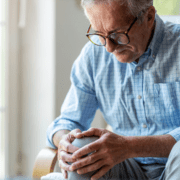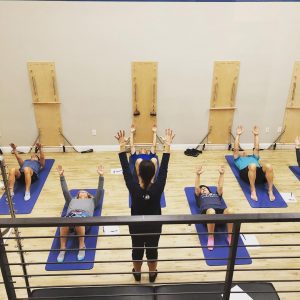Top Causes of Knee Pain and How to Get Lasting, Natural Relief
Knee pain affects millions of people worldwide, often interfering with daily activities such as walking, squatting, climbing stairs, and even getting in and out of the car.
It is one of the most common musculoskeletal complaints, second only to back pain. Whether your knee pain started suddenly or has worsened over time – you might be wondering – what’s really causing it? And can you get rid of it naturally?
The good news is that, in most cases, yes. Many common causes of knee pain can be addressed without medications, injections, or surgery. Here are some of the top reasons behind knee pain and what you can do to find lasting, natural relief that doesn’t involve medication, injections, procedures, or surgery:
1. Patellofemoral Pain Syndrome (Runner’s Knee)
Also known as “runner’s knee,” patellofemoral pain syndrome (PFS) is characterized by pain in the front of the knee, usually just below or behind the kneecap. This condition is often caused by improper movement patterns and muscle imbalances that place excessive pressure on your kneecap, leading to inflammation and discomfort.
To alleviate PFS, it’s important to avoid excessive kneeling, squatting, or repetitive knee bending until the pain subsides. For long-term relief, focus on strengthening the muscles surrounding your knee, particularly the hips and thighs, to improve stability and reduce stress on your kneecap. Corrective exercises that promote proper kneecap tracking, such as step-ups and lateral band walks, can help to further optimize knee function and prevent future flare-ups.
2. Iliotibial Band Syndrome (ITBS)
ITBS causes pain on the outer side of the knee and is commonly seen in runners and cyclists. The iliotibial (IT) band is a thick band of connective tissue running from the hip to the knee, and when it becomes tight or inflamed, it can lead to irritation and pain.
While many people resort to foam rolling for relief, this only provides temporary symptom management. To address ITBS at its root, focus on strengthening the glutes and core, as weak glutes often lead to overcompensation and excessive strain on the IT band. Correcting pelvic imbalances and optimizing hip mobility will also be key for long-term relief. Additionally, taking a temporary break from any aggravating activities will allow the inflammation to subside and the tissues to heal properly, provided you’re taking an active approach to tissue healing versus rest only.
3. Tendinitis (Jumper’s Knee)
Tendinitis occurs when the patellar tendon, which connects the kneecap to the shinbone, becomes inflamed. This condition is common in athletes and individuals who engage in frequent jumping or repetitive knee movements.
A common treatment for tendinitis is cortisone injections, but these only provide temporary relief and may contribute to further tissue damage over time. Instead, consider regenerative treatments like Shockwave Therapy, which naturally enhances your body’s ability to reduce inflammation and accelerate tendon healing. Once inflammation is managed, strengthening the hamstrings, glutes, and calf muscles will provide better knee support and reduce tendon strain. Incorporating eccentric exercises, such as slow step-downs, can also help build tendon resilience and prevent future injuries.
4. Osteoarthritis
Osteoarthritis (OA) is the gradual degeneration of cartilage in the knee joint. While it is a natural part of aging, experiencing constant pain and limited mobility does not have to be. Many people believe that knee arthritis inevitably leads to surgery, but the truth is that optimizing movement and reducing inflammation can be powerful tools in managing OA long-term, even with “bone on bone” OA.
Rather than relying on cortisone injections and pain medication, consider alternative treatments such as Regenerative Therapy (specifically EMTT) to target inflammation deep at the cellular level. From there, implementing corrective exercises that strengthen the muscles surrounding the knee – particularly your quadriceps, hamstrings, and glutes – can reduce joint stress and help prevent inflammation from returning. Since inflammation is the primary driver of pain in OA, addressing it naturally through movement and strength training can help you avoid major surgery while still finding lasting relief.
5. Meniscus Tears
The meniscus is a piece of cartilage that cushions the knee joint. Over time, wear and tear can lead to meniscus tears – which cause pain, stiffness, and occasional knee locking. Many people assume that surgery is the only solution, but research has shown that placebo surgery can be just as effective as actual meniscus surgery, suggesting that natural recovery is possible.
Managing a meniscus tear naturally involves first addressing the inflammation caused by the tear. As previously mentioned, EMTT and Shockwave Therapy (especially when combined) can be particularly effective in reducing pain and inflammation, often providing immediate relief. Beyond that, focusing on proper knee mechanics is essential. In many cases, the issue isn’t the tear itself, but rather a lack of mobility and movement in the knee joint that continues to aggravate it. A mechanical knee pain specialist can help identify and correct these dysfunctions. Once inflammation is controlled and knee mechanics are optimized, strengthening and conditioning the surrounding muscles can provide long-term relief without the need for injections or surgery.
Finding Long-Term Relief Naturally
For most cases of knee pain, the key to lasting relief is movement – not rest, avoidance, injections, or surgery. Whether your pain is caused by an overuse injury, muscle imbalance, or arthritis – addressing the root cause with targeted exercises and mobility work is essential. Reducing inflammation naturally is also crucial for long-term joint health. If you’re struggling to determine the root cause of your knee pain or finding the right treatment approach – consider working with a mechanical knee pain specialist who can guide you toward the best non-invasive, long-term solutions.
Dr. Carrie Jose, Physical Therapy Specialist, and Mechanical Pain Expert, owns CJ Physical Therapy & Pilates in Portsmouth, NH, and writes for Seacoast Media Group. If local to Portsmouth, NH, and looking for help – request a FREE Discovery Visit with one of her Specialists by CLICKING HERE.














